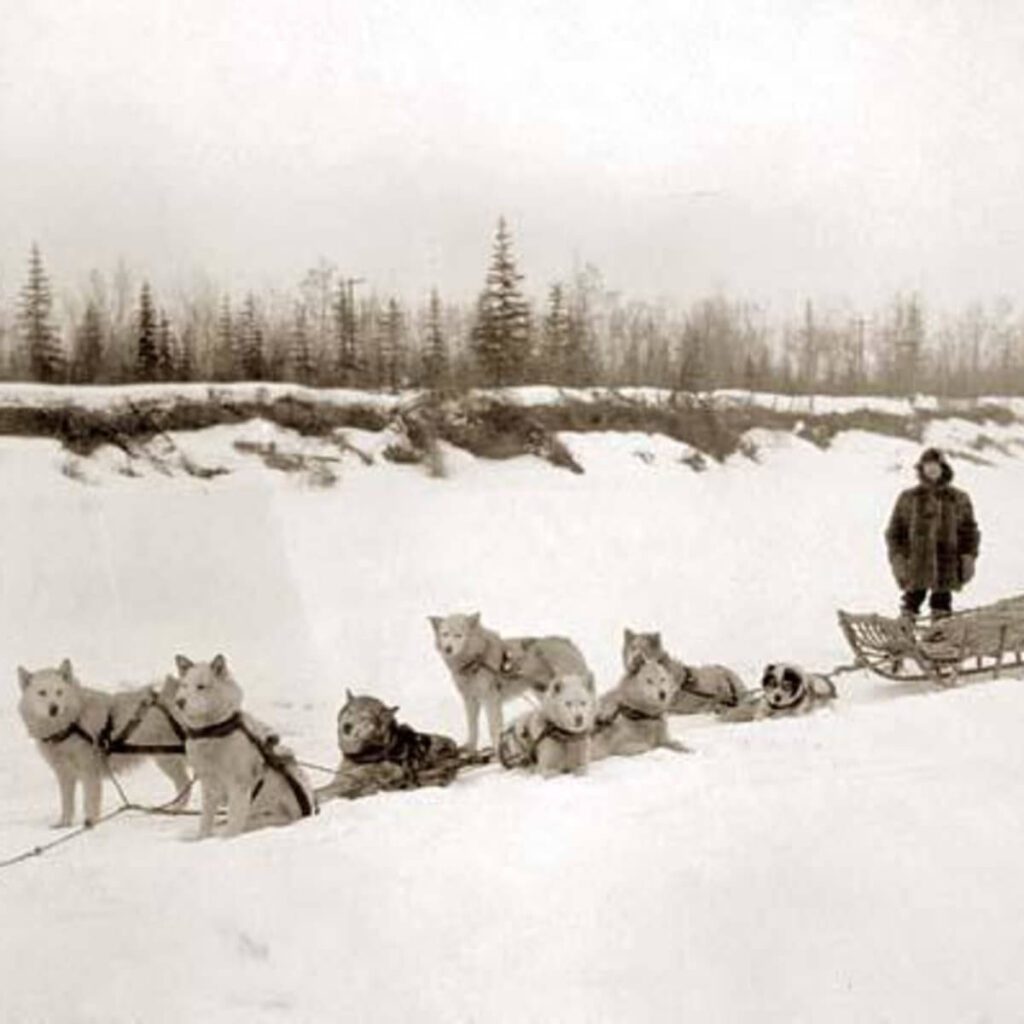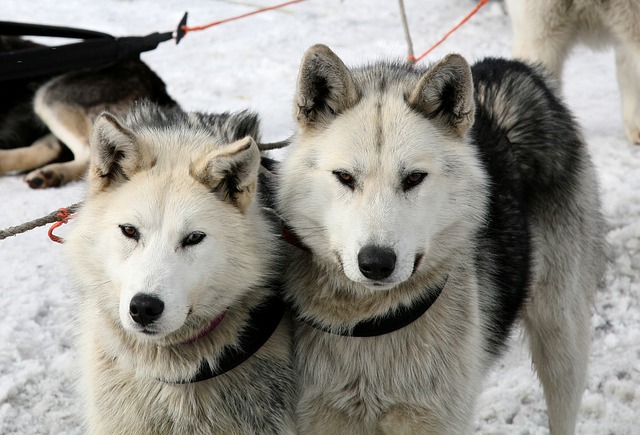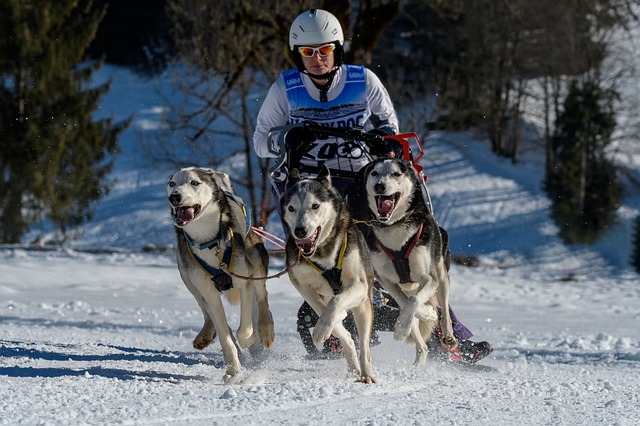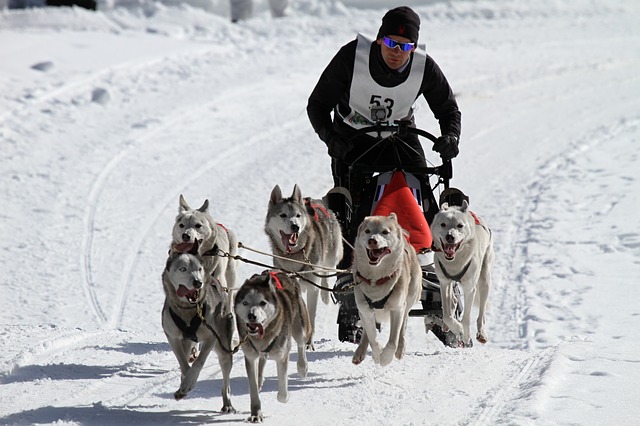Dog sled racing is a famous sport in the artic regions of the US, Russia, Greenland, Canada, and some European countries.
You have probably watched the action on the famous Iditarod dog races.
The whole sled dog thing dates as far back as 3,000 years ago where the first sled dogs were spotted somewhere in Mongolia.
Of course, the activity was mainly used for transportation purposes back then but over time, it has been turned into a recreational sport.
If you want to know a thing or two about sled dog teams, we’ve got the scoop for you.
Sled Dogs History

As hinted above, the history of dog sleds stretches back thousands of years, with evidence of early sled use found in archaeological sites across the Arctic regions.
Indigenous cultures, such as the Inuit, Yupik, and Sami, relied on dog sleds for transportation, hunting, and survival in harsh winter conditions.
The sleds allowed people to navigate vast snowy landscapes, travel long distances, and transport supplies and goods.
Dog sleds played a crucial role in expeditions to explore uncharted territories, such as the Arctic and Antarctic regions.
In the early 20th century, dog sleds were vital for delivering mail and supplies in remote areas without road access.
The famous Serum Run of 1925, also known as the “Great Race of Mercy,” saw dog teams transporting diphtheria antitoxin to Nome, Alaska, saving countless lives.
Today, while modern transportation has replaced dog sleds in many areas, the tradition of dog sledding continues as a beloved sport, a way to connect with nature, and a tribute to the enduring bond between humans and their loyal sled dogs.
NOTE:
In the early days of dog sledging, each dog was individually tied to the sled using a fan hitch, which worked well in open terrain.
However, as the practice of using sled dogs expanded, a tandem hitch system emerged as the preferred method, where dogs were paired up and worked together in tandem
Sled Dog Breeds & Teams

By definition, sled dogs are dogs trained to drag sleds across snow or ice.
Technically, any dog can pull a sled but there are some that are specifically bred for the job.
The most common ones as seen on dog racing events are dogs that are common in the Northern Hemisphere like Siberian Huskies, Alaskan Huskies, Eskimo dogs, Samoyeds, and Alaskan malamutes.
These dog breeds are known for their endurance, strength, and high energy levels, allowing them to pull heavy loads over long distances.
They also possess thick coats, well-developed muscles, and a strong work ethic, making them well-suited for the demanding and cold environments in which they traditionally operate.
The dog sledding sport is commonly referred to as mushing hence the team is called the mushing team while the person carried on the sled is the musher.
The word is coined from the French word ‘marche’ which stands for ‘run’ and ‘go’. The mushers are often heard saying ‘mush’ to the sled dogs to make them move.
Important Fact:
While the mentioned dog breeds can be used in dog sledding events, a majority of competitive racing sled dogs are actually Alaskan Huskies, which are not considered a “pure breed” according to AKC.
Alaskan Huskies tend to be smaller in size and have shorter fur compared to other breeds. Siberian Huskies may appear larger due to their fluffier coats.
Larger breeds like Malamutes are better suited for freight-hauling and slower-paced activities rather than racing, as they excel in pulling heavy loads over long distances.
The unique characteristics of Alaskan Huskies make them ideal for the speed and endurance required in competitive sled dog racing.
Dog Sled Positions

Like in a basketball or football team, dog sledding has positions of its own. Where a dog is placed has an impact on how the team performs. Essentially, there are four positions namely:
I. Lead Dog
The dog in this position stays in front of the pack and carries the responsibility of listening to the commands from the musher, responding to them, and ensures the team stays on course.
The lead dog position can have one or two dogs but it has been shown that the former works best than the latter.
A good lead dog should posses the following attributes:
- Should have strong leadership qualities, as they are responsible for setting the pace and direction of the team.
- Should be highly intelligent and able to make quick decisions on the trail, navigating obstacles and changes in terrain.
- Should be able to maintain focus and concentrate on following the musher’s commands to lead the team effectively.
- Should have good stamina and be able to maintain a consistent pace over long distances.
II. Swing Dogs
These run right behind the lead dog.
Swing dogs are typically leaders just like the lead dog but with less responsibility.
They have to understand commands and understand how the team is moving.
Other great attributes of swig dogs include:
- Need to be agile and quick to navigate turns and corners smoothly.
- They need to work in harmony with the lead dogs, responding to their cues while helping to guide the team.
III. Wheel Dogs
As the name suggests, the wheel dogs or wheelers actually turn the sled. They are located right in front of the sled.
Some mushers have one wheel dog but most have two or more canines.
Attributes:
- Often, these are large dogs with massive stamina and strength. They have to get the sled going when it gets stuck in ice or snow.
- They require good endurance, as they often encounter more resistance and need to power through challenging trail conditions.
- They should provide stability and help maintain balance, especially when navigating uneven terrain or descending hills.
- Should possess a calm and steady temperament, as they are closest to the sled and may experience more noise and commotion.
IV. Team Dogs
These can occupy any given position on the sled. Team dogs provide speed and momentum to the race.
Because of this, most mushers place their team dogs behind the swing dogs.
Attributes:
- Should have good strength to contribute to the pulling power of the team.
- Should be obedient and responsive to commands from the musher, following the lead dogs’ guidance.
- Should be adaptable to different positions within the team, being able to work anywhere in the lineup.
Check out this great video by WDIO for more insights on dog sled positions:
Disclaimer:
Dogs have varying personalities, so you may not get a dog that manifests all the attributes that I have highlighted above.
Like us humans, you will find dogs that are outgoing, shy, hard workers, or lazy.
A good musher should be able to figure out the best position for every dog that he or she has on his or her team.
When there is corporation and coordination in the team, a lot can be achieved in terms of the amount of weight that can be pulled or how far the team can cover.
Dropped Dogs
In sled dog racing, you may also come across “dropped dogs”…..
Dropped dogs are simply dogs that are temporarily removed from a team during a race or a long-distance sled dog event.
This could be due to injury, fatigue, or any other reason that may affect the dog’s ability to continue racing.
Speaking of injury and fatigue issues, many people often ask: can a dog fall out of a race?
THe short answer is: Certainly…
Old, sick, fatigued, and injured dogs are left in checkpoints until the race is done and the musher can go back for them.
Checkpoints have vets and other dog volunteers that take care of the dogs.
Dog Sled Teams Composition
How many dogs are in a sled team? And how many dogs in Iditarod team?
Well, it really depends on the weight of the sled and the distance of the race.
On average, you can have anywhere between 4 and 6 dogs if you are doing a solo sleigh.
If the dogs are pulling paired or family sleighs, the required number is 8-12 dogs.
In Iditarod, you are required to have 16 dogs at the beginning of the race and finish with a minimum of 6.
In sprint races, you can have a team of only three dogs.
However, when going on longer races which can go up to 250 miles, more dogs are required to pull the sled.
Similarly, a musher weighing 150 kg (330 lbs) certainly requires more dogs to pull the sled compared to the one weighing only 50kg (110 lbs.)
Sled Dogs Capabilities: Distance, Speed, & Weight

How long can a dog sled team run? How far can a dog sled go in a day? How fast do dog sleds go? and how much weight can sled dogs pull?
There are no one umbrella answers for these questions…
Different dogs can cover different distances based on training, weather conditions, the experience of the musher, and more.
Broadly speaking, an average sled dog can travel 20mph if doing sprint races and 10-14mph when going for longer distances.
In the latter case, the dog can go up to 90 miles over a period of 24 hours while pulling a weight of up to 85 pounds.
Some of the long races like the Iditarod races last for 8-10 days for fast teams and a whole month for slow teams.
The distance covered is approximately 994 miles (1600km) for both. Short races take about 1-2 days and cover 310 miles (500km).
Common Sled Dog Commands
Commands are essential for effective communication between the musher and the sled dogs, ensuring precise control and coordination during dog sledding activities.
Here are the most common dog sled commands:
| Command | Meaning |
| “Hike” or “Let’s Go | Signals the dogs to start running and begin pulling the sled. |
| “Whoa” or “Stop | Instructs the dogs to halt and bring the sled to a stop |
| “Gee” or “Right” | Directs the dogs to turn right |
| “Haw” or “Left” | Guides the dogs to turn left |
| “Easy” or “Slow” | Directs the dogs to slow down their pace and proceed with caution |
| “Line Out” or “Stretch” | Prompts the lead dog to move forward and straighten out the gangline, ensuring it is not tangled or twisted. |
| “On By” or “Leave It” | Instructs the dogs to pass by a distraction, such as another team or a tempting scent, without stopping or getting distracted |
| “Hup” or “Up” | Encourages the dogs to overcome an obstacle or climb uphill |
| “Gee Over” or “Right Over” | Directs the dogs to navigate a right turn while crossing over a trail or obstacle. |
| “Haw Over” or “Left Over” | Guides the dogs to navigate a left turn while crossing over a trail or obstacle. |
Basic Sled Dog Racing Equipment
A basic sled dog racing equipment consist of the sled, dog harnesses, and a gang line (the tool used to connect all the dogs on the sled).
To keep you posted with mushing equipment terminologies, here is a quick overview of the most common jargons you are likely to come across:
| Part | Description |
| Bed or Cargo Bed | A platform on a sled where gear or supplies are carried. |
| Bridle | A set of straps and fittings that connect the dog’s harness to the gangline or towline. |
| Brush Bow | A protective frame or guard at the front of the sled to prevent collisions with obstacles. |
| Drag Mat | A device attached to the sled to provide additional resistance and stability. |
| Driving Bow | A curved or U-shaped bar on the sled used for steering and control. |
| Footboards | Platform or footrests where the musher stands or braces while driving the sled. |
| Gee Pole | A long pole attached to the sled to help guide the team in the desired direction. |
| Gangline | A line that connects the dogs’ harnesses to the sled and distributes the pulling force. |
| Handlebar | A bar or grip on the sled that the musher holds onto for balance and control. |
| Neckline | A short line that connects the dogs’ collars or harnesses, helping to maintain spacing and prevent tangles. |
| Ouija Boards | Flat boards attached to the sides of the sled to provide stability on uneven terrain. |
| Rigging | The system of lines and attachments that connect the sled to the dogs and distribute the load. |
| Rough Locks | Metal spikes or teeth on the sled runners for improved traction on icy or rough surfaces. |
| Runners | The curved strips of wood or metal on which the sled glides over the snow or ice. |
| Side Rails | Upright bars or rails on the sides of the sled that help to contain the load and provide stability. |
| Slats | Long, narrow wooden or metal strips that reinforce the sled bed and provide additional strength. |
| Stake | A pointed rod or pole driven into the ground to secure the sled when stopped. |
| Snow hook | A large, metal hook designed to anchor the sled to the ground or a solid surface. |
| Snub line | A line used to secure the sled to a stationary object, allowing the musher to step away temporarily. |
| Stanchions | Upright posts or supports on the sled that provide structural integrity and attachment points. |
| Toboggan | A type of sled with a flat or curved bed, typically used for hauling supplies or equipment. |
| Toggles | Fasteners or loops used to secure various parts of the sled or equipment together. |
| Taglines | Additional lines attached to the sled or dogs to provide control and maneuverability in tight spaces. |
How Are Sled Dogs Trained?
Training typically starts when the dogs are young to foster a strong bond between musher and the canine team.
The training regimen focuses on building the dogs’ physical strength, endurance, and teamwork.
Regular exercise, including running and pulling weighted sleds or tires, helps develop their muscles and cardiovascular capacity.
Mushing commands such as “hike” (go) and “whoa” (stop) are taught to ensure precise communication between mushers and dogs.
Training sessions also incorporate teaching the dogs to navigate various terrains, obstacles, and weather conditions they may encounter during races. This includes exposure to snow, ice, trails, and changing landscapes.
Dogs are conditioned to follow the lead dog’s guidance, maintain line tension, and work in unison as a cohesive team.
Positive reinforcement techniques, such as praise, treats, and play, are employed to reinforce desired behaviors and maintain enthusiasm.
Training methods prioritize the well-being of the dogs, emphasizing proper nutrition, hydration, and regular veterinary care.
Like other dog training regimens, sled dog training is an ongoing process that requires patience, dedication, and a deep understanding of the dogs’ physical and mental capabilities.
How Much Do Sled Dogs Cost?
The cost of sled dogs can vary significantly depending on factors such as breed, training, age, and experience.
On average, a well-trained and experienced sled dog can cost anywhere from $3,000 to $4,000 or more. (Yes, some lead dogs can cost you up to $10,000).
However, top-performing racing sled dogs with exceptional mushing attributes can command even higher prices.
It’s important to consider that the initial purchase cost is only one aspect of the expenses involved in owning sled dogs.
Additional costs include veterinary care, food, equipment, training, and ongoing maintenance.
Proper care and training are crucial for the well-being and performance of sled dogs, so it’s essential to budget for these expenses in order to provide them with a healthy and fulfilling life as working athletes.
On average, you need $2000-$5000 per year to cater for each dog’s food, vet checks, vaccinations, training, ongoing maintenance, and other miscellaneous items.
For a whole sled dog team, you should be ready to spend between $30,000- 60,000 annually for care and maintenance.
Insightful Sled Dogs Facts (& Dog Sled Racing Facts)
- Sled dogs are not only skilled at pulling sleds but also excel in other dog sports such as skijoring (where they pull a person on skis) and canicross (where they run with a person on foot), showcasing their versatility and athleticism beyond traditional sled pulling.
- The world-famous Iditarod Trail Sled Dog Race in Alaska covers approximately 1,000 miles and showcases the incredible endurance and strength of sled dogs.
- The Yukon Quest is another renowned long-distance sled dog race that runs between Whitehorse, Yukon (Canada), and Fairbanks, Alaska (USA). It spans over 1,000 miles and tests both the musher’s and dogs’ endurance.
- Dog sled races can vary in distance, ranging from shorter sprint races that cover a few miles to long-distance races that span hundreds or even thousands of miles.
- Dog sled racing is not only a competitive sport but also a celebration of the rich history and cultural significance of dog sledding in regions with snowy and icy climates. It showcases the incredible capabilities of sled dogs and their integral role in human exploration and transportation throughout history.
- It is not advisable to put dogs that are enemies or best friends together. If you put dogs that are enemies, all they will do is argue, which simply means that you won’t achieve much. While dogs that are best friends are great when paid, sometimes they tend to goof off and play too much. The best options are dogs that are nice to one another and focused on pulling the sled.
Sled Dog FAQs
1. How Do Sled Dogs Help Humans Survive In Harsh Climates?
By providing transportation, hauling supplies, and assisting in search and rescue operations.
Their endurance, strength, and ability to navigate snowy terrain make them invaluable in remote and challenging environments.
2. Do Sled Dogs Enjoy Pulling Sleds?
Sled dogs are bred for their natural instinct and enjoyment of pulling.
It’s a fulfilling and rewarding activity for them, akin to a form of exercise and mental stimulation.
They thrive on the physical and mental challenges that pulling a sled presents.
3. Is Dog Sledding Cruel?
When done responsibly with proper care and consideration for the well-being of the dogs, dog sledding is not considered cruel.
Responsible mushers prioritize the health, safety, and happiness of their dogs, providing appropriate nutrition, veterinary care, rest, and a stimulating environment.
4. Do sled dogs get cold paws?
Rarely. Sled dogs are resilient and adapt to their environment.
When running, their feet stay warm due to increased blood flow.
However, when they first rise from rest, they may lift a paw to stimulate circulation.
They can also curl up in the snow or retreat to their shelter for warmth.
Booties worn by sled dogs mainly protect against abrasions, not to keep their paws warm.
Their natural instincts and physical conditioning help them thrive in their natural habitat.
5. How Long Do Sled Dogs Live?
The lifespan of sled dogs varies depending on factors such as genetics, care, and how long they work before retiring from active mushing.
On average, sled dogs can live between 10 to 14 years.
Well-cared-for sled dogs that retire early from active mushing can live even longer, enjoying a comfortable life as human companions or in other roles.
6. Why Are Sled Dogs Chained Up?
Sled dogs are sometimes chained up to keep them safe and secure.
Chaining is a common practice when dogs are not actively working or supervised.
Chains or lines are used to prevent dogs from wandering off, getting into fights with other dogs, or running into dangerous situations.
7. Is dog sledding an Olympic sport?
No. While dog sled racing was once included in the 1932 Winter Olympics in Lake Placid as a demonstration event, it has never been included in the official program of the recent Winter Olympic Games.
Recommendations:
Best sled dog harness: Check this post: 10 Best Weight Pulling Harness for Dogs
As an Amazon Associate, we may receive a small commission from qualifying purchases but at no extra cost to you. Learn more. Amazon and the Amazon logo are trademarks of Amazon.com, Inc, or its affiliates.

